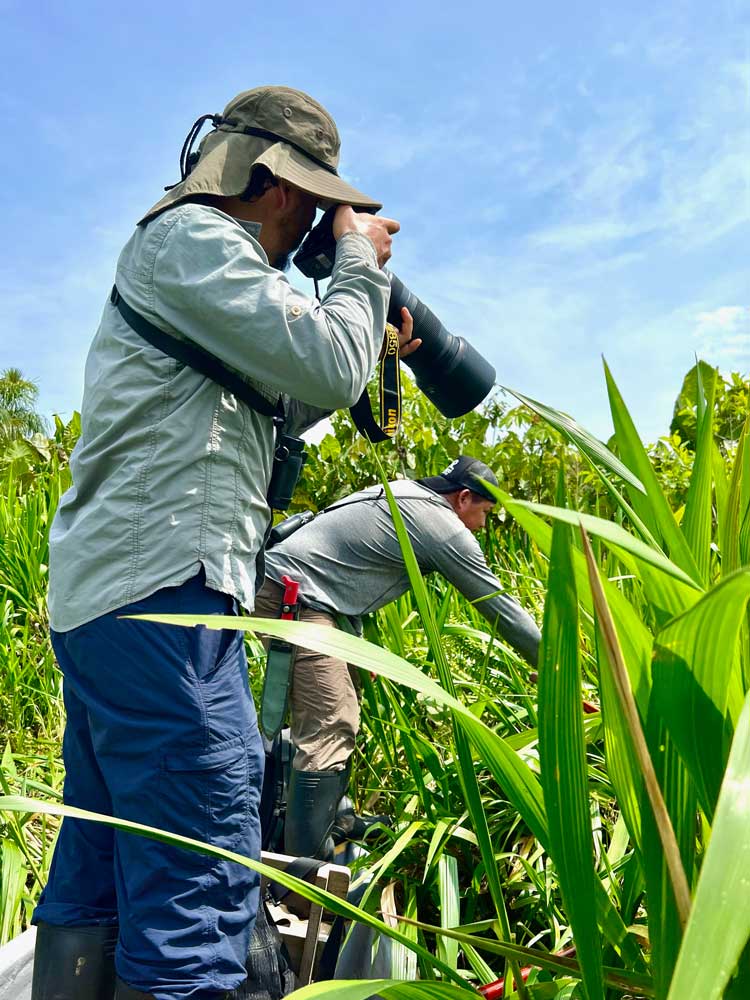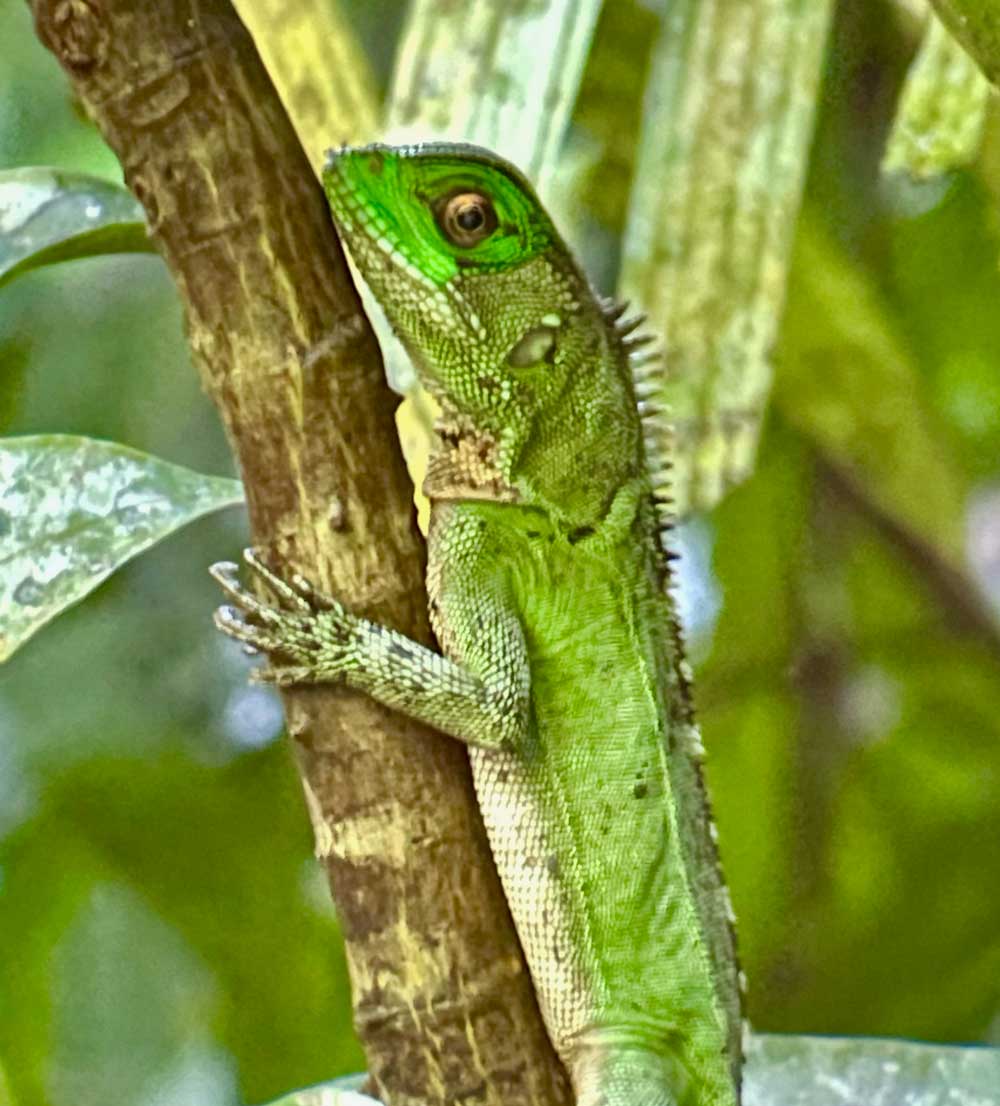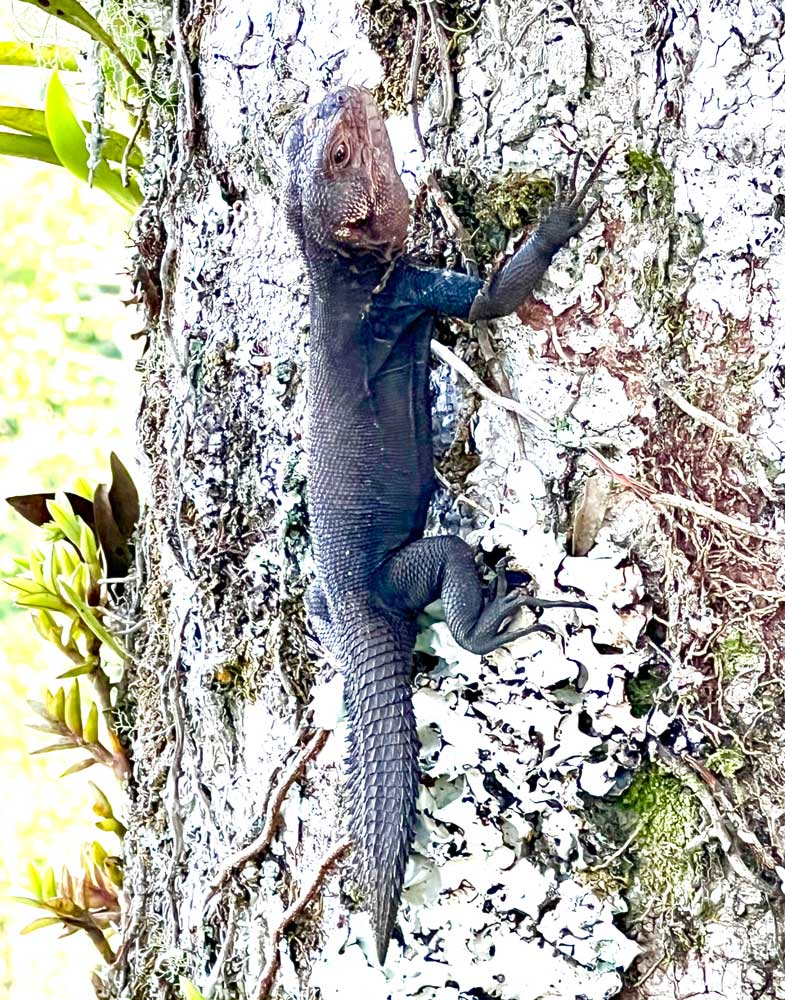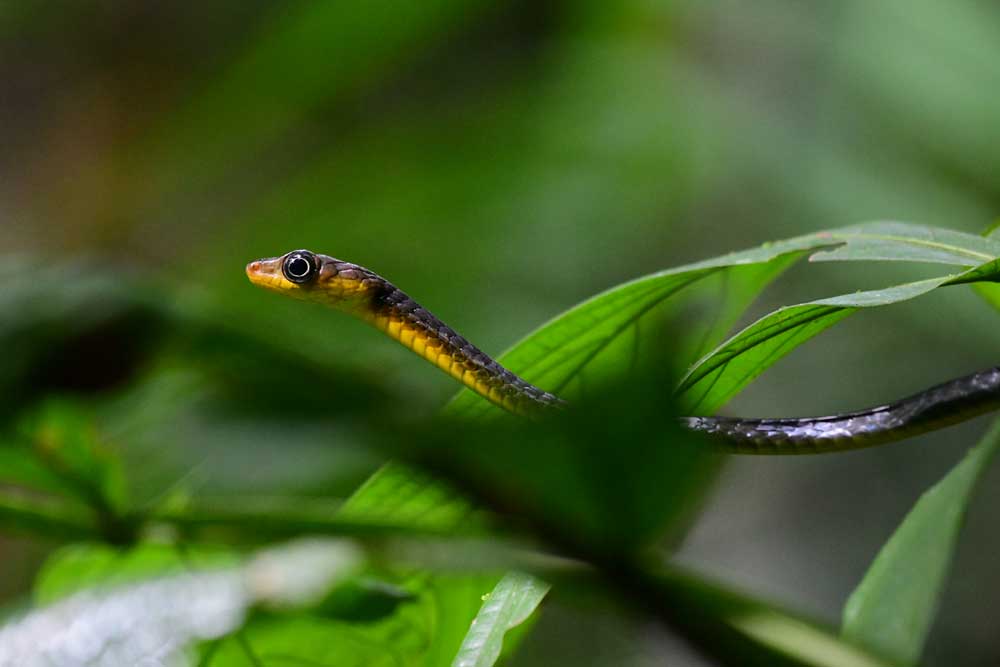In contrast to the anaconda and caiman, some of the most interesting herps in this region are also the smallest.
In the late 1990s the native Kichwa Añangu Community in the Ecuadorian Amazon had a difficult decision to make. Since the mid 1960’s, oil companies have explored, drilled and extracted petroleum from the rich deposits beneath the Napo River Basin, a major watershed of the Amazon River. In Yasuni National Park, home to the Kichwa Añangu people, the protected national park status had not entirely prevented oil production within its borders. Roads, pipelines and drilling platforms had been constructed within the 10,000 square kilometer national park.
Petroleum production is Ecuador’s largest industry and often conflicts with environmental protections. Other Napo Basin indigenous communities had exchanged oil rights on their rainforest lands for quick profits. Some came to regret their decisions as they witnessed degradation of the lands and water that had sustained their people for hundreds of years. The Kichwa Añangu elders studied their options extensively and ultimately turned down oil profits to create a sustainable ecotourism economy for their community.

Getting the shot. Photo by David M. Schultz
The Kichwa Añangu worked with non-profit organizations to build and manage the spectacular Napo River Ecolodge on Añangu Lake. In 2006, the Kichwa Añangu Community assumed full control and today owns and operates one of the finest and most sustainable tourist lodges in the entire Amazon.
The Napo Wildlife Center takes extensive measures to protect the rainforest ecology. No motorized boats or vehicles are allowed access to the lodge. All supplies are brought in on hiking trails or canoes paddled up Añangu Creek from the Napo River to the Napo Ecolodge. In addition to the Ecolodge on Añangu Lake, more lodging is available in the native Kichwa Añangu Village at the Napo Cultural Center along the Napo River. Visitors there also explore the rainforest but spend more time experiencing the lives of the Kichwa Añangu People. The native-owned and operated Napo Ecolodge, Napo Wildlife Center and Napo Cultural Center are a great ecotourism success story for the rainforest, indigenous Amazonians and their guests.

South America crested toad (Rhinella margaritifera) is also known as the crested forest toad. Photo by Sean Sharpe
In November 2023 I traveled with my wife Mary and a small group of friends to Yasuni National Park in the Amazon rainforest of Ecuador. Our base was the Napo Wildlife Center and Ecolodge. This UNESCO Biosphere Reserve has not been hunted or fished in more than 20 years, creating a bounty of wildlife viewing opportunities. Yasuni National Park claims the world’s highest biodiversity (most species per square kilometer) with 121 reptile and 155 amphibian species as well as 610 bird, 204 mammal and 268 fish species. Plant species diversity is also among the highest on earth. Experts believe the extreme biodiversity is a result of the year-round warm and moist rainforest climate that has remained relatively stable for 10 million years.
During our five days and nights on the reserve, I focused on the search for reptiles and amphibians but was often distracted by monkeys and spectacular birds. We conducted about half our search time from the lodge’s canoes and half on foot. Each day included either a 4:30 a.m. alarm or night hike when nocturnal and crepuscular herps are more likely to be seen. Due to the midday air temperatures that rose above 95 degrees Fahrenheit (35+ degrees Celsius) with 100% humidity, I also preferred the darker periods.
Onward in Canoes
We were in for quite an adventure. Our native guide Freddie probed the shoreline vegetation with his paddle as we inched the canoe forward. Every shadow and hole could hide our objective, or at least a portion of it. We stopped to focus our eyes on a dark recess in the thick foliage. I squinted and saw a faint pattern that might have been a discarded truck tire anywhere else besides the Amazon. No, it was not tire tread. They were scales! “Anaconda,” whispered our naturalist guide Jairo Sanchez. “It’s five or six meters long. That’s as big as they get.”

Green anaconda (Eunectes murinus). Photo by David M. Schultz
I slowly stood up in the canoe to photograph my first green anaconda (Eunectes murinus) just 10 feet away. Freddie cautiously opened the tangled vegetation with his paddle. He had grown up on the Napo River in the upper Amazon of Ecuador and was familiar with the world’s largest snake (the reticulated python can be longer but not as heavy). Freddie was wary not to disturb the resting giant.
Jairo explained that this anaconda was digesting a meal, probably a black caiman (Melansuchus niger). Caiman that frequent Añangu Lake are a favorite prey of the anaconda, a surprise to me because of the thickly-scaled skin and bone protecting the caimans’ muscle mass. Digesting a single caiman can take two weeks according to guide Jairo. Deep shoreline vegetation at the mouth of a small creek entering the lake is a favorite hiding and resting place for the snakes.

This anaconda was 5 or 6 meters in length. Photo by David M. Schultz
Much of my interest was focused on the lake and creeks where the black caiman, green anaconda, turtles and frogs lurked along with piranha and giant arapaima fish. From a distance we occasionally saw dragon-like forms rise just above the lake’s surface. With binoculars we could differentiate the black caiman’s scaly back from the arapaima’s long waving dorsal fin. The caiman often cruised with just their head and large eyes above the water’s surface. Both animals can grow to enormous size, the black caiman to five meters (16 ft.) or more and the giant arapaima to three meters (9.8 ft.) and 275 kg (600 lbs.). The black caiman is endemic to South America and the largest living species of the family Alligatoridae.
Both the black caiman and green anaconda are nocturnal predators, which explains why we were advised not to walk along the lake’s shoreline at night even though our cabins were perched near the water.

The black caiman (Melansuchus niger) often cruised with just their head and large eyes above the water’s surface. Photo by David M. Schultz
In contrast to the anaconda and caiman, some of the most interesting herps in this region are also the smallest. While hiking to a rainforest canopy observation platform early on our third morning, a tiny scarlet frog hopped off the trail into a pile of leaf litter. I watched it for a few seconds but it disappeared as I prepared my camera. It was a poison dart frog of the genus Oophaga. The bright coloration warns potential predators of its toxicity in a survival strategy known as aposematism.
The previous day our group had visited native guide Freddie’s home, the Kichwa Añangu Village on the Napo River. There we had the opportunity to shoot bamboo darts from their long carved-wood blowguns. Historically some indigenous Amazonians hunted with darts or arrows dipped in the toxic skin secretions of poison dart frogs. The frogs accumulate the poison from their diet of termites, ants and mites. The concentrated batrachotoxin is one of the most toxic poisons known to science. Poison dart frogs raised in captivity are not toxic due to diets without the batrachotoxin-laden invertebrates. Later that morning I photographed two lizards about 36 m (118 ft.) above the forest floor, two favorites of my Yasuni herp hunt due to their sky-high living environment.

Amazon forest dragon also known as the Amazon broad-headed wood lizard (Enyalioides laticeps). Photo by Sean Sharpe
The Napo Wildlife Center has installed a steel observation platform high in the rainforest canopy alongside a giant kapok tree. We arrived early enough to avoid the jungle heat as we scaled numerous steps to the viewing platform. While many in our group spotted toucans, macaws and parakeets in bright blues, greens, reds and yellows, I searched the kapok tree for camouflaged arboreal lizards. A spiny-tailed iguana (Enyalioides annularis) appeared on the tree and played hide-and seek with my camera. Later a well-concealed Amazon bark anole (Anolis ortonii) caught my attention with its movement. After descending the viewing platform to the forest floor we located an Amazon coachwhip also known as the rusty whipsnake (Chironius carinatus).

Whip scorpion. Photo by David M. Schultz
On a night hike, Jairo’s sharp eyes spotted a beautiful young Brazilian rainbow boa (Epicrates cenchria). I searched in my headlight beam for more poison dart frogs or coral snakes but was rewarded instead by two bizarre invertebrates, a tail-less whip scorpion and a walking stick insect both larger than my hand.

Rainbow boa (Epicrates cenchria) as seen at night. Photo by David M. Schultz
The next day on a trail hike deep into the rainforest, we found an emerald green Amazon forest dragon also known as the Amazon broad-headed wood lizard (Enyalioides laticeps). Just steps later a common South America crested toad (Rhinella margaritifera) hopped across the trail and Jairo held it in his palm for a quick photo. A slender brown sipo (Chironius fuscus) was sighted shortly afterward. As tropical afternoon rain began to fall we quickened our pace back toward the canoe but stopped when we came upon an Amazon banded tree anole (Anolis transversalis) completing a shed.

Bark anole (Anolis ortonii). Photo by David M. Schultz
That night a powerful thunderstorm passed just over the lodge. Lightning flashed nearly every second fully lighting our thatched-roof cabin and the entire lake beyond. Swirling winds blew through the windows’ bug screens lifting our curtains horizontally. Thunder claps rocked the jungle and howler monkeys roared in between the blasts. Two hours later near silence returned to the rainforest with just the chirping of insects to put us back to sleep.
Paddling Up Añangu Creek
The following morning we paddled Añangu Creek that drains Añangu Lake to the Napo River. We spotted a green parrot snake (Leptophis ahaetulla) slithering through the shoreline branches. While capuchin monkeys played in the canopy high above, we found a pale white map tree frog (Boana geographica) resting inside an up-curled leaf. A yellow-spotted Amazon river turtle (Podocnemis unifilis) slipped off its log perch into the creek as we approached.

Tropical thornytail iguana is also known as the Amazon thornytail iguana (Uracentron flaviceps). Photo by David M. Schultz
Later in the day we paddled back to the small creek where we located the anaconda on our first day. Its resting place seemed to be vacated but the opposite bank’s vegetation was disturbed. This time our anaconda hunt was brief. Curled up in the leaves and grass, only partially covered, was another giant anaconda. Much of its body, thicker than my thigh, was exposed to bright sunlight giving us excellent photo opportunities.

Amazon banded tree anole (Anolis transversalis) in shed. Photo by David M. Schultz
On our last day in the Amazon we rose at 4 a.m. for an early departure to another of the world’s most legendary and unique reptile habitats. Rain fell as our canoe drifted down Añangu Creek in the glow of headlamps. In many sections, the rainforest completely enclosed the dark creek transforming it into a surreal tropical forest tunnel. The Napo Wildlife Center’s boots and raingear kept us dry for the two hour journey to our rendezvous point on the Napo River. There we boarded our covered power boat to ferry us back to Coco, Ecuador two hours upriver. At the Coco Airport we boarded our first of three flights to our final destination. Eventually we were rewarded for our long travel day as we toasted the sunset 1,000 km (600 miles) off the coast of mainland Ecuador in the Galapagos Islands.
David M. Schultz is a biologist, environmental engineer and author with degrees in Biology (B.S.) and Engineering Science (M.S.) from the University of California, Berkeley.


